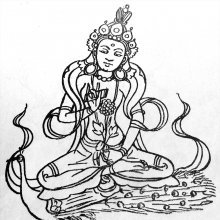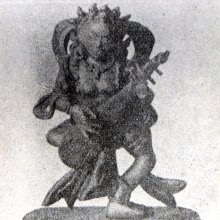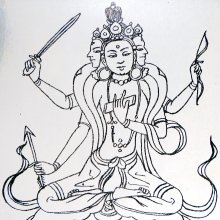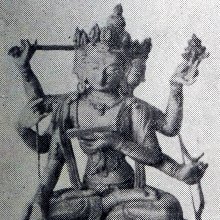Reddish-white: 1 definition
Introduction:
Reddish-white means something in Hinduism, Sanskrit. If you want to know the exact meaning, history, etymology or English translation of this term then check out the descriptions on this page. Add your comment or reference to a book if you want to contribute to this summary article.
Images (photo gallery)
In Hinduism
Natyashastra (theatrics and dramaturgy)
Source: Shodhganga: Elements of Art and Architecture in the Trtiyakhanda of the Visnudharmottarapurana (natya)The Reddish-white (colour) is denoted by the Sanskrit word Gaura and is associated with Vīra or the “ heroic sentiment”, which represents one of the nine kinds of Rasa (“soul of Drama”), according to the Viṣṇudharmottarapurāṇa, an ancient Sanskrit text which (being encyclopedic in nature) deals with a variety of cultural topics such as arts, architecture, music, grammar and astronomy.—According to the Viṣṇudharmottarapurāṇa gaura i.e., radish white is the colour of this sentiment. Mahendra is the God of this sentiment. The Nāṭyaśāstra states that the vīra-rasa relates to the superior type of persons and has excitement as its basis.

Natyashastra (नाट्यशास्त्र, nāṭyaśāstra) refers to both the ancient Indian tradition (shastra) of performing arts, (natya—theatrics, drama, dance, music), as well as the name of a Sanskrit work dealing with these subjects. It also teaches the rules for composing Dramatic plays (nataka), construction and performance of Theater, and Poetic works (kavya).
See also (Relevant definitions)
Partial matches: White.
Full-text: Shyetaksha, Shyeta, Kinnara, Gita, Vajradhara, Rohini, Gaura, Vajradharma, Cuta, Vajradharmalokeshvara, Padmadakini, Nakshatra, Mari, Ghola, Dharmadhatuvagishvara, Namasamgiti, Mahamayamandala.
Relevant text
Search found 14 books and stories containing Reddish-white; (plurals include: whites). You can also click to the full overview containing English textual excerpts. Below are direct links for the most relevant articles:
The Indian Buddhist Iconography (by Benoytosh Bhattachacharyya)
Figure 207 - Four Dance Deities: Gītā
Figure 120 - (Avalokiteśvara): Vajradharma
Rasa Jala Nidhi, vol 2: Minerals (uparasa) (by Bhudeb Mookerjee)
Part 1 - Characteristics of Manahshila or Manas-shila (realgar) < [Chapter XIII - Uparasa (14): Manahshila or Manas-shila (realgar)]
Satapatha-brahmana (by Julius Eggeling)
Kāṇḍa V, adhyāya 5, brāhmaṇa 2 < [Fifth Kāṇḍa]
Kāṇḍa V, adhyāya 3, brāhmaṇa 1 < [Fifth Kāṇḍa]
Kāṇḍa III, adhyāya 3, brāhmaṇa 1 < [Third Kāṇḍa]
Rasa Jala Nidhi, vol 3: Metals, Gems and other substances (by Bhudeb Mookerjee)
Part 1 - Characteristics of Coral (pravala) < [Chapter XXII - Gems (12): Pravala (coral)]
Bharadvaja-srauta-sutra (by C. G. Kashikar)
Cosmetics, Costumes and Ornaments in Ancient India (by Remadevi. O.)
1.1. Use of Candana (Sandal) < [Chapter 1 - Cosmetics]



